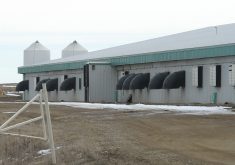There are plenty of theories about what makes yeast behave badly during the beer making process, but none have precisely pinned down the problem.
Farmers, maltsters and brewers gathered at the recent Western Barley Growers Association annual meeting to talk about the syndrome, known as premature yeast flocculation.
Alexander Spears, a brewing scientist from the University of Dalhousie, worked with researchers from the University of Saskatchewan to assess whether fungus in the grain is responsible.
He said the malt may contain a factor that somehow damages the yeast and stops it from fermenting. The yeast cells cluster together too soon and sink before brewing is completed.
Read Also

Phosphate prices to remain high
Phosphate prices are expected to remain elevated, according to Mosaic’s president.
“We don’t quite know why this happens,” said Spears.
“One of the things that affects fermentability is how fast that yeast settles. If it stays a long time, you may have some problems.”
The flavour of the beer could be affected or it might veer so far off specifications it has to be thrown away.
Spears’s lab malted and brewed fungal infected barley from the U of S and found premature flocking.
“The maltsters usually get blamed for everything by the brewers, so this message is that the maltsters can now blame you,” he told barley growers.
Spears suggested the fungi could also appear in the malt plant.
Dirk Bendiak, quality service manager at Molson Coors, said reliable tests are needed before the malting and brewing process starts.
“When I see malt that is kind of grey and dingy, that is my first indicator something isn’t exactly right,” he said.
He also knows premature flocculation is likely when the malt barley crop is poor.
“When I see a crappy crop, I have a guess I am going to face some headaches,” he said.
The poor malt crops of 2002 and 2004 produced yeast that would not convert starches to sugars properly. The 2010 crop is similar.
“Will the consumer see a huge difference? Probably not, but each year the beer might be different,” Bendiak said. “Every year is different in wine and perhaps we should take advantage of it.”
Joe Hertich of Anheuser-Busch Inc. said the syndrome could be crop related, but he said studies suggest procedures in the malt house may be responsible.
A six-year project investigated the problem in 22 malt plants with 32 malting units using barley from six growing regions. The study tested two-row malt blends against six-row barley varieties and checked equip-
ment, grain sources, carbon dioxide levels and water supplies.
Many of the problems seemed to be linked to mechanical problems with inconsistent water temperatures and poor ventilation in the steep rooms. In some cases, pipes in the plant were dirty.
“Look again and ask the maltster, ‘what did you do different when you were dealing with this malt crop problem,’ ” he said.
“It is as simple as making sure grain is ventilated at critical times and C02 is not allowed to accumulate.”
The study also found 79 percent of these incidents happened during warm weather in the United States, but there was a situation in Canada in January where germination control temperatures were not correct.
Anheuser-Busch has since developed a 16-point checklist for malt house steep rooms and 12 germination requirements.
Malting companies that did not update their processing systems were sometimes dropped as company suppliers.
He does not know if PYF is related to a specific micro-organism but doubts it is the main factor because his company buy grain from around the world.
“In our work across all those plants, we never associated micoflora with any of these events. We never had a situation where we had any unidentified variables when we worked these things out,” he said.















